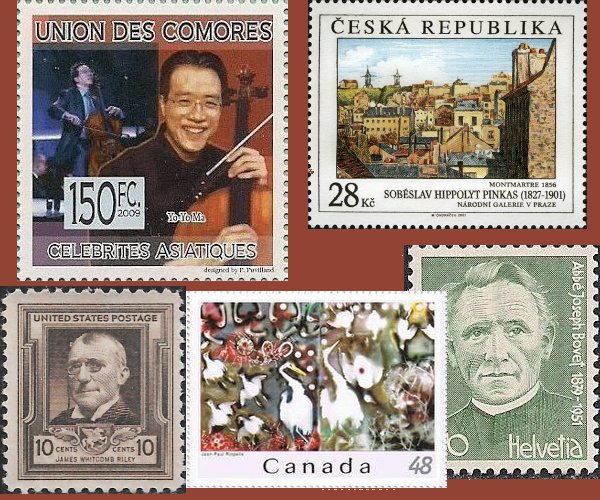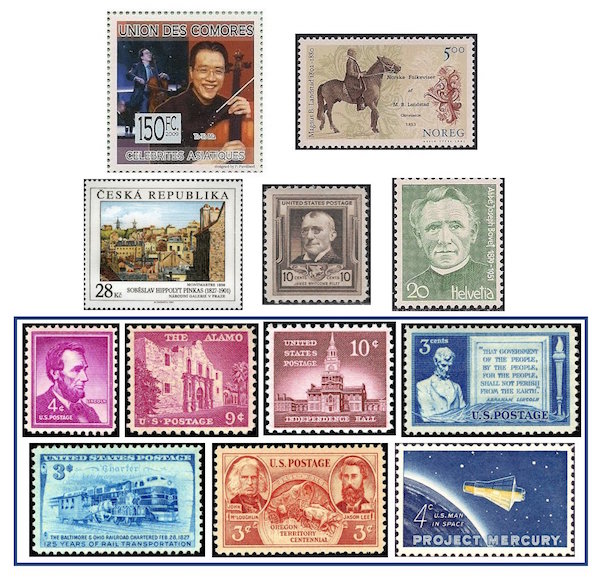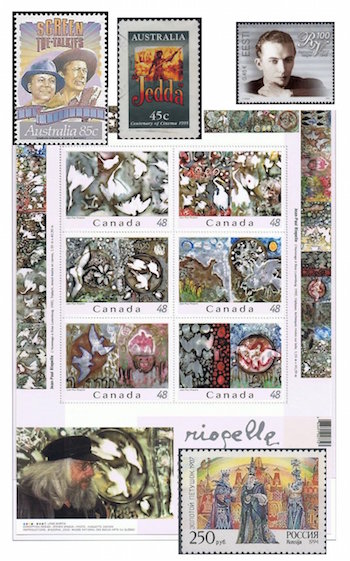The Arts on Stamps of the World —October 7
An Arts Fuse regular feature: the arts on stamps of the world.

By Doug Briscoe
Our only true “name” artist for October 7 is the world’s most famous living cellist, Yo-Yo Ma (born 1955). Given his local residence, I’m sure some of you must know him personally. (Although he has appeared on WGBH on a number of occasions, our paths have never crossed.) Yo-Yo Ma’s parents were musical, his mother a singer and his father a professor at Nanjing; they were in Paris when Yo-Yo was born. When he was seven, the family moved to New York. Fame came early. A child prodigy, he played before Presidents Eisenhower and Kennedy that same year. At Juilliard, where Emanuel Ax became a close friend, he studied with Leonard Rose, and he played in the Marlboro Festival Orchestra under Casals before entering Harvard. The landmark appearances, the splendid recordings, and the accolades have amassed—geometrically, one is tempted to say—in the intervening years. Just last month he played all six of the Bach solo suites in a single concert at the Hollywood Bowl. This 2009 stamp from the Comoro Islands is one from a sheet honoring Asian celebrities in various fields.
Norwegian parish priest Magnus Brostrup Landstad (7 October 1802 – 8 October 1880) was a psalmist and poet who, Wikipedia tells us, “published the first collection of authentic Norwegian traditional ballads in 1853.” He also created the Landstad hymnal (Landstads kirkesalmebog, 1861), which included about fifty of his own hymns. He died the day after his 78th birthday. The 2002 stamp recognizes his bicentennial.
The Czech painter and caricaturist Soběslav Pinkas was also born on this day (1827) to a significant figure in the Revolutions of 1848, Adolf Maria Pinkas. It was around the time of the revolutions that the young man adopted the old name “Soběslav” (abandoning his given names of Hippolyt, Karel, Maria, and František) as a declaration of Czech nationalism. He began in the law but after the suppression of the revolution he turned to the arts, studying in Prague, Munich, and Paris. In the last named city he fell under the artistic influence of Jean-François Millet. On his return home to Bohemia he began a 25-year career as a drawing teacher. He died in Prague on 30 December 1901. His grandson, incidentally, was the actor George Voskovec, whom you may remember from 12 Angry Men (1957), in which he played the European-born Juror 11. The Czech stamp shows one of Pinkas’s French canvases, Montmartre (1856). Other examples of his work are Workers at Montmartre and Boy with Gun (both before 1901). Here, too, is his Self-Portrait from 1853.
The American writer of stories in dialect and children’s poetry James Whitcomb Riley (October 7, 1849 – July 22, 1916) came from Indiana. As a child he and his friends put on amateur theatricals. Luckily for Riley, a library opened in his town when he was ten, and this opened worlds for the boy, but because he went to school only irregularly, he was twenty years old before being graduated from the eighth grade. During the Civil War, his family took in an orphan girl who was the inspiration for Riley’s poem “Little Orphant Annie”, which in turn served as the model for Harold Gray’s similarly named 1924 comic strip and its numerous money-making spinoffs. From the start, as in the poem “The Old Swimmin’ Hole”, Riley used Hoosier dialect in his writings. He submitted poems to newspapers, eventually getting paid for them, but he would make better money—in time, much better money—on the reading and lecture circuit. (In the meantime he worked as a sign painter and snake oil salesman, among other things.) Though uneven, and often criticized for its poor form (Ambrose Bierce, Edgar Lee Masters), Riley’s work was admired by such figures as Longfellow, Samuel Clemens, and William Dean Howells. He was friendly with Eugene V. Debs and helped establish Paul Laurence Dunbar‘s career. John Singer Sargent painted a portrait of him in 1903.

Another musical priest (like Magnus Brostrup Landstad) was Swiss composer and choral conductor Joseph Bovet (1879 – 10 February 1951). Ordained in 1905, became maître de chapelle at Fribourg. He wrote over 2000 (!) pieces of music, half of them secular songs on nature, life in the country, family, and other popular subjects. The most famous, “Le Vieux Chalet”, written in 1929, has been translated into 17 languages.
Charles R. Chickering (October 7, 1891 – April 29, 1970) was, between 1947 and the year of his death, the designer of no fewer than 77 US postage stamps as an employee of the Bureau of Engraving and Printing. Prior to that he had worked as an illustrator, between the wars contributing to The Saturday Evening Post and numerous other magazines. During World War I he was given a macabre assignment: to make drawings of the wounds of dead soldiers for medical research. Among the Chickering stamps we’ve already seen in these pages, both of these quite recently, are those for Frederic Remington (the one reproducing the painting The Smoke Signal) and Devil’s Tower. Next month (18 Nov.) we’ll present his stamp for Polish pianist and statesman Ignacy Jan Paderewski. For today I offer up a small sample of Chickering’s other philatelic work. Those of you of a certain age will surely recall the once-upon-a-time very commonly seen 4-cent Lincoln stamp, part of a definitive series that also included the Alamo and Independence Hall; the others here are for the Gettysburg Address, B&O Railroad, the Oregon Territory, and Project Mercury.
Next we come to the Australian filmmaker Charles Chauvel (7 October 1897 – 11 November 1959). His parents were farmers, and his uncle was an important World War I general, a commander at Gallipoli and in the Middle East. Their ancestry was French Huguenot, resident in England from 1685. Chauvel studied commercial art and acted as a production assistant on a number of Australian silent films before proceeding to Hollywood, but remained there for only a year or so before returning home to make first film, The Moth of Moonbi (1926). His first sound motion picture was a semi-documentary, In the Wake of the Bounty, starring a pre-Hollywood Errol Flynn. His more celebrated films include Forty Thousand Horsemen (1940), about his uncle’s unit, Australian Light Horse Brigade (it starred Australian actor Chips Rafferty, who appears on the first stamp with Chauvel), and the first Australian color feature, Jedda (1955), which is the subject of the second stamp and was Chauvel’s last film. He went on to write, produce, and direct a television documentary series called Australian Walkabout (1958).
October 7 is also the birthday of Estonian popular song composer Raimond Valgre (born Raimond Tiisel; 1913 – 31 December 1949). As a youth he learned to play piano, then accordion, drums, and guitar. He served in the Red Army during World War II, playing in the orchestra of the 8th Estonian Rifle Corps, but after the war he fell afoul of the Soviet authorities, who disapproved of his Western influences (jazz, Gershwin, Richard Rodgers, Michel Legrand…), and ultimately (1948) his music was actually banned in the USSR. Valgre became embittered and alcoholic, dying of an accident (sources are reticent on the nature of this accident) at the age of 36. His songs, of which the most famous is the Saaremaa Waltz, began to enjoy a revival in the Soviet Union in the 60s. Most of them are in Estonian, but some are in German and English. The stamp came out for his centenary four years ago.

Canadian painter and sculptor Jean-Paul Riopelle (7 October 1923 – 12 March 2002) was born in Montreal and turned to surrealism in his early twenties. He moved to Paris after the war and had there his first solo exhibition in 1949. Within a short time he had moved on from surrealism to lyrical abstraction. For twenty years beginning in 1959 he had a relationship, artistic and romantic, with the American abstract expressionist Joan Mitchell. The large sheet from the year 2003 offers sections of his L’Hommage à Rosa Luxemburg (1992), painted in tribute to Mitchell after her death. The piece, acrylic and spray paint on canvas, is in three “segments” (here is the second in situ at the Musée national des beaux-arts du Québec), each of which is subdivided into connected panels. The stamp sheet presents, from top to bottom, two stamps from each of the segments.
Based on a Pushkin poem, Nikolai Rimsky-Korsakov’s opera Le coq d’or (The Golden Cockerel, in Russian Zolotoi petushok [Золотой петушок]) had its première on this date (OS September 24) in 1909 in Moscow, more than a year after the composer’s death. A new production was staged at the Mariinsky Theater in December 2014 under Vladimir Putin’s chum Valery Gergiev.
A nod to two stamp-deserving Anglo writers: Elizabethan/Jacobean poet and playwright John Marston (baptized 7 October 1576 – 25 June 1634) and brilliant Australian writer and broadcaster Clive James (born 7 October 1939).
A graduate of the University of Massachusetts with a B.A. in English, Doug Briscoe worked in Boston classical music radio, at WCRB, WGBH, and WBUR, for about 25 years, beginning in 1977. He has the curious distinction of having succeeded Robert J. Lurtsema twice, first as host of WGBH’s weekday morning classical music program in 1993, then as host of the weekend program when Robert J.’s health failed in 2000. Doug also wrote liner notes for several of the late Gunther Schuller’s GM Recordings releases as well as program notes for the Boston Classical Orchestra. For the past few years he’s been posting a Facebook “blog” of classical music on stamps of the world, which has now been expanded to encompass all the arts for The Arts Fuse.
